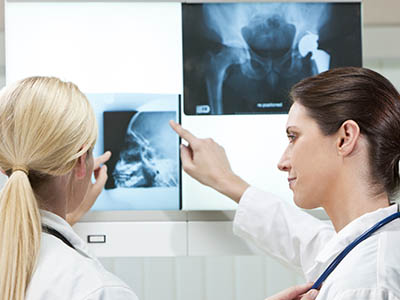
Watch the Video below, or by CLICKING HERE.
On a daily basis, I hear people with hip pain say they just got an X-ray or an MRI and a surgeon told them they have “bone on bone”, and they need a hip replacement. But I want to dispel the myth of “bone on bone” as a proper diagnosis and as the cause of hip pain.
“Bone on bone” is not an official medical term. When a doctor uses it, they usually mean Arthritis, or Degenerative Joint Disease. By measuring the space between the two bones in the hip (the pelvis and the femur), doctors can determine if the space is smaller than a normal range of values. Many health professionals assume that a diagnosis of joint space narrowing is automatically the cause of any hip pain the patient is experiencing.
The problem with that is there is a significant amount of research showing that the majority of people with joint space narrowing, or arthritis do not have hip pain. This study of asymptomatic (not having pain) people looked at thousands of X-rays and MRI’s of asymptomatic people, 80 % of whom had joint space narrowing. 80% showed arthritis and degenerative joint disease but these patients did not have any pain. So hip pain must be caused by something other than “bone on bone”.
The study also showed that in two thousand one hundred and fourteen people without hip pain, the X-ray or MRI showed something structurally wrong with the hip: 37% had a cam deformity (a thickening in the neck of the femur right under the head); 67% had a pincer deformity (a protrusion of the socket bone), and 68% had a labral (the cartilage ring on the outside of the hip socket) injury.
All of this shows that an X-ray or MRI does not do a good job of telling us what's actually causing hip pain.
The reason “bone on bone” is a misnomer is because the hip joint is a space that allows the femur to move inside the socket. The space can narrow and still allow movement. However, if the joint has no space left between the bones, if they were truly “bone on bone” there would be no motion at all, and the force of walking would actually bruise or break the femur. In a rare instance where a patient has zero hip mobility, the joint may have narrowed so much as to justify this diagnosis, but it is rare.
The subject of my doctoral thesis was studying the forces that travel through the leg when we walk or run. When you walk, every time your heel hits the ground two to three times your body weight of force travels through your hip joint. If I’m 200 pounds, 600 pounds of force travels through my hip join when I walk. It’s even more when I run. It only takes 800 pounds of force to break a femur in half.
If your femur and your pelvis were actually touching, 600 pounds of walking force would slam the bones together, causing bone bruising, bone fractures or fragments from a simple activity like walking.
I think “bone on bone” is a metaphor that causes a lot of unnecessary fear in patients. The reality is the hip bones are suspended by ligamentous capsules with fluid inside that enclose the joint space. In addition, tendons, ligaments and muscles keep the bones suspended in tension.
There is a new anatomy model, created by an orthopedic surgeon, called biotensegrity. The model shows that if the fascial network and muscles become weak, tight or misaligned, they will not be able to hold the bones in proper alignment. These musculoskeletal dysfunctions are the real causes of hip pain.
The majority of people with hip pain, then, need to work with a physical therapist to find the musculoskeletal dysfunction and repair it through functional movement activities. This is great news because patients can heal and get rid of hip pain without medications, injections or surgery.



